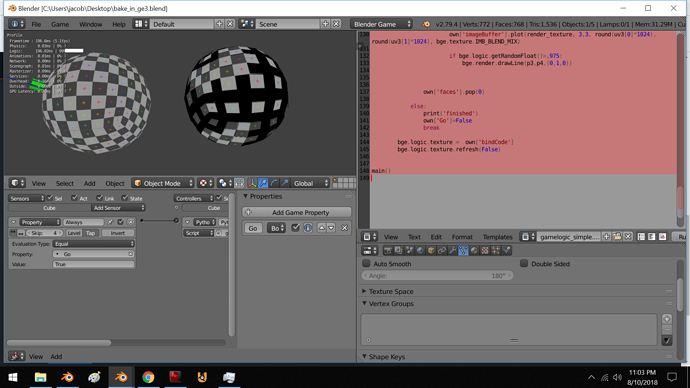this script is setup to bake overlaying geometry sitting over a quad to a texture realtive to the UV of the polygon
I will be using it to bake low poly standins of my planet after it’s generated in game.
help me refine it?
import bge
def main():
cont = bge.logic.getCurrentController()
own = cont.owner
always = cont.sensors['Always']
if 'faces' not in own:
#trying to get the texture loaded and replace the current texture with it
TargetObj = own.scene.objects['Bake_Target']
texture = bge.texture.Texture(TargetObj, 0,0 )
own['bindCode'] = texture
print(texture.bindId)
imageBuffer = bge.texture.ImageBuff(1024, 1024, color=0, scale=False)
texture.source = imageBuffer
print(texture.source)
own['imageBuffer']=imageBuffer
print(type(own['imageBuffer']))
own['cam2'] = own.scene.objects['cam2']
#bge.logic.texture = textureID
#print(bge.logic.texture.source)
faces = []
for i in range(own.meshes[0].numPolygons):
#placeholder
face = own.meshes[0].getPolygon(i)
v1 = own.meshes[0].getVertex(0,face.v1)
v2 = own.meshes[0].getVertex(0,face.v2)
v3 = own.meshes[0].getVertex(0,face.v3)
width = 1024
height = 1024
#print(v1.UV)
uv1 = v1.UV
uv2 = v2.UV
uv3 = v3.UV
uv1[0]*=width
uv1[1]*=height
uv2[0]*=width
uv2[1]*=height
uv3[0]*=width
uv3[1]*=height
dist = round((uv1-uv2).magnitude)
dist2 = round((uv2-uv3).magnitude)
faces.append([face ,[dist,dist2]])
own['faces']=faces
print('stored faces')
elif always.positive:
Trans = own.worldTransform
for i in range(1):
if len(own['faces'])>=i+1:
face = own['faces'][i][0]
v1 = own.meshes[0].getVertex(0,face.v1)
v2 = own.meshes[0].getVertex(0,face.v2)
v3 = own.meshes[0].getVertex(0,face.v3)
v4 = own.meshes[0].getVertex(0,face.v4)
v1xyz = Trans * v1.XYZ
v2xyz = Trans * v2.XYZ
v3xyz = Trans * v3.XYZ
v4xyz = Trans * v4.XYZ
mid1 = v1xyz.lerp(v2xyz, .5)
mid2 = v1xyz.lerp(v4xyz,.5)
N = ((v1.normal + v2.normal)/2).normalized()
N = ((N + v3.normal)/2).normalized()
N = ((N + v4.normal)/2).normalized()
mid1 += N*2
bge.render.drawLine(v1xyz,v2xyz,(1,0,0))
bge.render.drawLine(v2xyz,v3xyz,(1,0,0))
bge.render.drawLine(v3xyz,v4xyz,(1,0,0))
bge.render.drawLine(v4xyz,v1xyz,(1,0,0))
point = v1xyz.lerp(v3xyz,.5)
point2 = point + (N*2)
bge.render.drawLine(point,point2,(0,0,1))
for X in range(own['faces'][i][1][0]):
for Y in range(own['faces'][i][1][1]):
p1 = v1xyz.lerp(v2xyz, X/own['faces'][i][1][0])
p2 = v4xyz.lerp(v3xyz, X/own['faces'][i][1][0])
p3 = p1.lerp(p2, Y /own['faces'][i][1][1])
p4 = p3 + (N*.25)
own['cam2'].worldPosition = v1xyz.lerp(v2xyz,.5) + (N*2)
#print('aligning minor axis')
own['cam2'].alignAxisToVect(own['cam2'].getVectTo(mid2)[1],0,1)
own['cam2'].alignAxisToVect(own['cam2'].getVectTo(mid2)[1],1,1)
#print('aligning camera z')
own['cam2'].alignAxisToVect(N,2,1)
own['cam2'].worldPosition = p4
render_texture = bge.texture.ImageRender(own.scene, own['cam2'])
render_texture.capsize = (3,3)
render_texture.refresh()
uv1 = v1.UV.lerp(v2.UV,X/own['faces'][i][1][0])
uv2 = v4.UV.lerp(v3.UV,X/own['faces'][i][1][0])
uv3 = uv1.lerp(uv2, Y/own['faces'][i][1][1])
own['imageBuffer'].plot(render_texture, 3,3, round(uv3[0]*1024), round(uv3[1]*1024), bge.texture.IMB_BLEND_MIX)
if bge.logic.getRandomFloat()>.975:
bge.render.drawLine(p3,p4,(0,1,0))
own['faces'].pop(0)
else:
print('finished')
own['Go']=False
break
bge.logic.texture = own['bindCode']
bge.logic.texture.refresh(False)
main()

